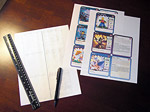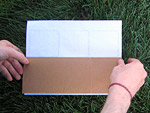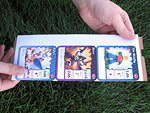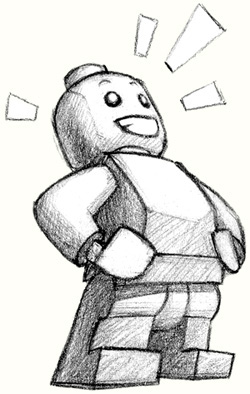Chapter Two: The Mighty Minifig
| "The goal of all inanimate objects is to resist man and ultimately defeat him." |
| - Russell Baker |
A minifig is a cute and friendly-looking little fellow, but
don't let his appearance fool you. Beneath his lovable exterior, a
minifig is a remorseless killer. He’ll hack your heart
right out of your chest if he thinks he can get away with it -
his minifig village could live for months off the meat of a good-sized
Human heart. Until then, he’s happy to go on massive fratricidal
rampages in hopes of gaining favor with his godlike Human overlords.
Despite his horrifying misanthropy, the minifig is a simple creature,
defined by four statistics: Skill, Move, Armor,
and Cost. (In later chapters, some advanced minifigs will also
have unique Specialties that give them extra abilities.)
A minifig's attributes are described on a Minifig Stat Card like the one at right. If you're fielding a large number of different
kinds of minifigs, you'll want to photocopy and cut out their cards
and keep them on the table for easy reference during battle. In the
Core Rules, however, most minifigs are exactly the same, distinguished only by their choice of weapons and equipment.
| The Minifig Gender Monotone |
 |
In BrikWars, Humans and other types of players are referred to in gender-neutral terms. Why, then, are minifigs always "he?"
Humans come in a dizzying variety of genders, but minifigs are limited almost exclusively to one, thanks to the gendercidal efforts of the FedoraNuker and his Fedophile minions.
Browsing any typical toy store, the Fedophiles' success speaks for itself: In most brands and themes, non-male minifigs are outnumbered twenty to one if they haven't been eliminated entirely.
Admit it. You wouldn't even have noticed if I hadn't said anything. |
Skill: d6 - see 4.2: Action
 A minifig’s Skill statistic reflects his ability to accomplish
goals. It's a composite measurement of natural aptitude, intelligence,
training, and luck. A minifig’s Skill statistic reflects his ability to accomplish
goals. It's a composite measurement of natural aptitude, intelligence,
training, and luck.
A Skill statistic is always a die size rather than a number,
and a unit rolls that type of die whenever it attempts to use its Skill.
The minifig's Skill of d6 means he rolls one six-sided die
each time he makes a Skill Roll (4.2: Action).
A minifig's Skill rating is used to determine his degree of success or failure whenever
he attempts a difficult action, usually to use an object or weapon
to whack another minifig across the skull. These actions are given Use ratings according to difficulty, normally a number between
one and six, and the minifig must roll that number or higher on his
Skill Roll to succeed.
Move:
5" - see 4.1:
Movement
 The Move statistic describes the distance a minifig can move in
a single turn, under normal conditions. At normal speed, a standard minifig can move five inches. The Move statistic describes the distance a minifig can move in
a single turn, under normal conditions. At normal speed, a standard minifig can move five inches.
Armor:
4 - see Chapter 3: Minifig Weapons
 A minifig’s Armor statistic tells how much Damage he can withstand from a single attack – in this case, four points.
If he’s hit by an attack doing four points of Damage or less,
the blow glances harmlessly away and the minifig can continue fighting.
If the attack does five points of Damage or more, he’s killed
instantly. Knock the minifig over and, if appropriate, sever a couple
of body parts. A minifig’s Armor statistic tells how much Damage he can withstand from a single attack – in this case, four points.
If he’s hit by an attack doing four points of Damage or less,
the blow glances harmlessly away and the minifig can continue fighting.
If the attack does five points of Damage or more, he’s killed
instantly. Knock the minifig over and, if appropriate, sever a couple
of body parts.
| Minifigs don't have "hit points" like some Humans might have come to expect from other games. In BrikWars, an attack either kills a minifig or it doesn't. In battles that might involve dozens or even hundreds of minifigs at once, a system of individually-tracked hit points is too burdensome for players to manage from turn to turn. |
Cost:
4CP - see 1.1:
Overview of Play
 The Cost statistic describes a unit’s value in Construction
Points (CP), which players can
use to ‘buy’ soldiers, weapons, vehicles, and fortifications.
Players who don't make the obvious choice to ignore Construction Points entirely may decide to set a CP budget in order to ensure that all armies
are of equal value, or they may calculate their armies' CP after the fact and adjust the balances accordingly. A minifig unit costs 4CP,
not counting weapons and equipment. The Cost statistic describes a unit’s value in Construction
Points (CP), which players can
use to ‘buy’ soldiers, weapons, vehicles, and fortifications.
Players who don't make the obvious choice to ignore Construction Points entirely may decide to set a CP budget in order to ensure that all armies
are of equal value, or they may calculate their armies' CP after the fact and adjust the balances accordingly. A minifig unit costs 4CP,
not counting weapons and equipment.

| While the LEGO MINIFIGURE™ is the seminal example of the minifig species, minifigs are now available from a large number of manufacturers in nearly-limitless variety. |
|
| Using Stat Cards |
The Minifig card, shown above, is an example of a single-sided stat card. Single-sided cards are used for basic units without the kinds of special details that would need an extra panel for explanatory text. These cards can be printed and cut out individually, but it's also common for players to print or photocopy all of their single-sided cards onto a single sheet of paper for quick reference.
Upcoming chapters introduce a variety of advanced units with Specialties that grant them extra abilities. These types of units are given two-sided stat cards, so that the descriptions of their Specialties can be printed on the card's backside. While a two-sided card can be printed out flat in the same way as the single-sided card, its real purpose is to be cut out, folded in half, and glued or taped together. |

(Download
the Two-Sided Blank card) |
 |
If you'd like to make some nice two-sided stat cards for your game, start by downloading or creating the graphics files for the cards you'd like. (Print-resolution graphics of all of BrikWars' stat cards,
including blank cards, alternate versions, and graphics
templates for making your own custom cards, are all freely
available for download on the Downloads page of the
BrikWars website, at http://www.brikwars.com/downloads.)
Start by printing out your selected cards. Here, we've used a graphics editing program to stack three cards on a page - feel free to set your cards in whatever sizes and arrangements you like, as long as they all fold along the same line in the middle. Using a straightedge and pencil, draw a line on the back side of the printout to show where the fold line between the two sides of the cards will be - this will help you out later. |
 |
The next step is to glue the cards together with spray adhesive. You'll be doing a good amount of spraying, so pick a well-ventilated area where you don't mind getting glue all over everything. Ideally, you have your own industrial spray booth and clean drop cloths; we just used the lawn.
If you're in a hurry, you can simply glue and fold the paper onto itself, but for a more durable feel it's better to fold the printouts around cardstock, cardboard, or even index cards. Here, we've cut some nice chunks of cardstock out of a package of frozen pizza. Their size doesn't have to be precise, as long as they have at least one straight edge and are large enough to cover the cards to which you'll be gluing them. It's important to choose pieces of cardstock that don't have writing or high-contrast printing on them - these can show through the paper and ruin the look of your cards. |
 |
 |
You'll start by spraying a coat of adhesive on the back of the printout and on both sides of your cardstock. When the glue has had time to set up, line up the edge of the cardstock with the fold line you've drawn on the back of the printout. With everything properly aligned, press the paper and the cardstock together to secure the bond, and then fold the loose flap of paper around the cardstock. You can avoid wrinkles if you make sure to start at the fold line and work outwards when you're pressing them together.
Depending on your adhesive, you may have time to spray coats over several pages while the first coat of glue is setting up, or you may have to spray and mount each set of cards one at a time. Read the instructions on the bottle! Gluing too quickly can be just as bad as waiting too long. |
 |
 |
After the glue has had time to set properly, it's time to cut the cards apart. Cut all the straight edges first. For a professional-quality edge, you can use a straightedge, a cutting mat, and patient strokes with a fresh craft knife. We used scissors.
When the straight edges are done, come back in with scissors and trim the rounded corners. |
 |
Congratulations! Your card is finished and ready for its exciting career as reference material. |
| The Rise of the Minifig |
 In the beginning, brick-built figures rose up from the primordial plastic to evolve over time from blocky misshapen homonculi into the earliest simple minifigs*.
Led by the Yellow King, the fountainhead of all lines of royalty to follow, the civilization of these new minifigs flourished. They quickly mastered the art of hinged castlebuilding with the creation of the legendary Yellow Castle 375, and established the four orders of Sticker Knights to eliminate all non-Yellow figures in a smiley-faced campaign of friendly racial genocide. In the beginning, brick-built figures rose up from the primordial plastic to evolve over time from blocky misshapen homonculi into the earliest simple minifigs*.
Led by the Yellow King, the fountainhead of all lines of royalty to follow, the civilization of these new minifigs flourished. They quickly mastered the art of hinged castlebuilding with the creation of the legendary Yellow Castle 375, and established the four orders of Sticker Knights to eliminate all non-Yellow figures in a smiley-faced campaign of friendly racial genocide.
With the progress of history, this carefree population of medieval knights blossomed into modern cities of yellow and smiling citizens, brutally divided by hat style into strict castes of policemen, firemen, construction workers, and finally, girls. The construction worker class developed a substantial body of knowledge surrounding the use and properties of the mysterious ABS bricks with which they worked, and independent cabals of construction-workerist theoreticians began investigating their potential for interdimensional space travel and bioengineering.
Before long, all of minifig society was caught up in the race to extend their reach to the plastic stars above. While the first SpaceShips were secretly assembled within high-security police and fire stations, hidden hospitals staffed by faceless and limbless proto-figs worked around the clock to design and create the SpaceMen to pilot them.
It's impossible to know the sources of genetik material used in the injection molding of these ultimate superfigs. It can be assumed that no yellow-colored species was left untapped, from the smiley-faced minifig citizens, to their limbless protofig servants, to the noodly-armed yellow giants of ages past. (Any suggestion that the bloated white-colored Dooploks were involved, however, risks swift retribution from a SpaceMan Planetary Sterilization Squad.) There is no questioning the end result, first achieved by the prestigious research team at Hospital 555: the Deadly SpaceMan, the most dangerous bioengineered organism ever to exist.
* - Following the repeated destruction of the universe, and the subsequent scattering of SpaceMan influence backwards across history, it is believed by some that the entire minifig species was fathered by SpaceMen time-displaced into the distant past. This theory is popular with anti-evolutionists who refuse to accept that they could be descended from a simple plastic brick, but it requires that the first SpaceMen would had to have been intelligently designed by protofigs in the end of BR 1,977, an even earlier version of the universe. While the presence of protofigs and Hospital 555 in several antecedent Retconstruktion universes seems to lend credence to this theory, no evidence has been found for the existence of SpaceMen or any other modern minifig prior to BR 1,978.
|
|
|